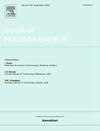Melting of Fe and Gd oxide loaded geopolymers with nuclear fuel for ex-vessel core catcher systems
IF 2.3
3区 工程技术
Q1 NUCLEAR SCIENCE & TECHNOLOGY
引用次数: 0
Abstract
Geopolymers have demonstrated a significant potential in various fields of the nuclear industry. They can serve as enhanced sacrificial materials offering increased safety and mitigating consequences in a hypothetical severe nuclear accident. Additionally, geopolymers show potential use as immobilization matrixes for radioactive waste disposal due to their advantageous properties and polymeric structures. Their properties, including high gamma radiation resistance, low water content, and the ability to incorporate various elements and species to customize their physico-chemical properties, suggest that geopolymers may be applied for various systems, e.g. sacrificial materials for core catchers of current or future plant concepts. However, further research is required to fully understand the interaction between geopolymers and corium melts, to describe their physico-chemical properties at extreme temperatures, high-temperature phase behaviour, etc. In present manuscript, we focused on geopolymers with embedded Gd2O3 and Fe2O3 as neutron absorber and functional melt modifier, respectively. Such composite could be a convenient sacrificial material for ex-vessel core catcher systems. We conducted two midscale melting experiments of geopolymer mixtures with prototypic corium to estimate the solidus and liquidus of the mixture and asses the phase behaviour. The mixture of geopolymer and prototypic corium showed similarities to previously described corium-concrete systems with solidus temperature around 1500 °C and liquidus around 1900 °C. A miscibility gap was present in the system between the oxide and iron melt. Iron melt solidified into a large block, but to microdroplets as well. Three distinct phases (silicate-rich, uranium-rich and metallic) were observed in the ingots. The geopolymer materials appeared to have prospective properties from melting and phase point of view, thus deserve further attention in the severe accident R&D.
载Fe和Gd氧化物地聚合物与核燃料在容器外堆芯捕集器中的熔化
地聚合物在核工业的各个领域显示出巨大的潜力。它们可以作为增强的牺牲材料,在假设的严重核事故中提供更高的安全性和减轻后果。此外,由于其有利的性质和聚合结构,地聚合物显示出作为放射性废物处理固定基质的潜在用途。它们的特性,包括高抗伽马辐射,低含水量,以及加入各种元素和物种以定制其物理化学特性的能力,表明地聚合物可以应用于各种系统,例如用于当前或未来植物概念的核心捕集器的牺牲材料。然而,地聚合物与堆芯熔体之间的相互作用,描述其在极端温度下的物理化学性质,高温相行为等,还需要进一步的研究。在本论文中,我们重点研究了嵌入Gd2O3和Fe2O3作为中子吸收剂和功能熔体改性剂的地聚合物。这种复合材料可以作为一种方便的容器外岩心捕集器的牺牲材料。我们进行了两次与原型堆芯的地聚合物混合物的中等规模熔融实验,以估计混合物的固相和液相,并评估相行为。地聚合物和原型堆芯的混合物与先前描述的堆芯混凝土体系相似,固体温度约为1500℃,液体温度约为1900℃。系统中氧化物与铁熔体之间存在混相间隙。铁熔体凝固成大块,但也凝结成微滴。在钢锭中观察到三种不同的相(富硅酸盐、富铀和金属)。从熔融和相的角度来看,地聚合物材料具有良好的性能,值得在重大事故的研究和开发中进一步重视。
本文章由计算机程序翻译,如有差异,请以英文原文为准。
求助全文
约1分钟内获得全文
求助全文
来源期刊

Annals of Nuclear Energy
工程技术-核科学技术
CiteScore
4.30
自引率
21.10%
发文量
632
审稿时长
7.3 months
期刊介绍:
Annals of Nuclear Energy provides an international medium for the communication of original research, ideas and developments in all areas of the field of nuclear energy science and technology. Its scope embraces nuclear fuel reserves, fuel cycles and cost, materials, processing, system and component technology (fission only), design and optimization, direct conversion of nuclear energy sources, environmental control, reactor physics, heat transfer and fluid dynamics, structural analysis, fuel management, future developments, nuclear fuel and safety, nuclear aerosol, neutron physics, computer technology (both software and hardware), risk assessment, radioactive waste disposal and reactor thermal hydraulics. Papers submitted to Annals need to demonstrate a clear link to nuclear power generation/nuclear engineering. Papers which deal with pure nuclear physics, pure health physics, imaging, or attenuation and shielding properties of concretes and various geological materials are not within the scope of the journal. Also, papers that deal with policy or economics are not within the scope of the journal.
 求助内容:
求助内容: 应助结果提醒方式:
应助结果提醒方式:


